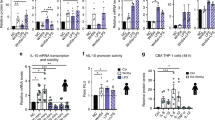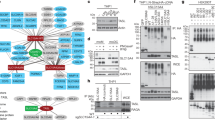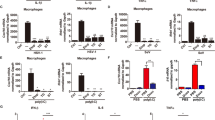Abstract
Toll-like receptors (TLRs), which recognize pathogen-associated molecular patterns, and members of the pro-inflammatory interleukin-1 receptor (IL-1R) family, share homologies in their cytoplasmic domains called Toll/IL-1R/plant R gene homology (TIR) domains1,2,3. Intracellular signalling mechanisms mediated by TIRs are similar4, with MyD88 (refs 5–8) and TRAF6 (refs 9, 10) having critical roles. Signal transduction between MyD88 and TRAF6 is known to involve the serine-threonine kinase IL-1 receptor-associated kinase 1 (IRAK-1)11 and two homologous proteins, IRAK-2 (ref. 12) and IRAK-M13. However, the physiological functions of the IRAK molecules remain unclear, and gene-targeting studies have shown that IRAK-1 is only partially required for IL-1R and TLR signalling14,15. Here we show by gene-targeting that IRAK-4, an IRAK molecule closely related to the Drosophila Pelle protein16, is indispensable for the responses of animals and cultured cells to IL-1 and ligands that stimulate various TLRs. IRAK-4-deficient animals are completely resistant to a lethal dose of lipopolysaccharide (LPS). In addition, animals lacking IRAK-4 are severely impaired in their responses to viral and bacterial challenges. Our results indicate that IRAK-4 has an essential role in innate immunity.
This is a preview of subscription content, access via your institution
Access options
Subscribe to this journal
Receive 51 print issues and online access
$199.00 per year
only $3.90 per issue
Buy this article
- Purchase on Springer Link
- Instant access to full article PDF
Prices may be subject to local taxes which are calculated during checkout






Similar content being viewed by others
References
O'Neill, L. The Toll/interleukin-1 receptor domain: a molecular switch for inflammation and host defence. Biochem. Soc. Trans. 28, 557–563 (2000)
Akira, S., Takeda, K. & Kaisho, T. Toll-like receptors: critical proteins linking innate and acquired immunity. Nature Immunol. 2, 675–680 (2001)
Kimbrell, D. A. & Beutler, B. The evolution and genetics of innate immunity. Nature Rev. Genet. 2, 256–267 (2001)
Wasserman, S. A. Toll signaling: the enigma variations. Curr. Opin. Genet. Dev. 10, 497–502 (2000)
Wesche, H., Henzel, W. J., Shillinglaw, W., Li, S. & Cao, Z. MyD88: an adapter that recruits IRAK to the IL-1 receptor complex. Immunity 7, 837–847 (1997)
Medzhitov, R. et al. MyD88 is an adaptor protein in the hToll/IL-1 receptor family signaling pathways. Mol. Cell 2, 253–258 (1998)
Adachi, O. et al. Targeted disruption of the MyD88 gene results in loss of IL-1- and IL-18-mediated function. Immunity 9, 143–150 (1998)
Kawai, T., Adachi, O., Ogawa, T., Takeda, K. & Akira, S. Unresponsiveness of MyD88-deficient mice to endotoxin. Immunity 11, 115–122 (1999)
Cao, Z., Xiong, J., Takeuchi, M., Kurama, T. & Goeddel, D. V. TRAF6 is a signal transducer for interleukin-1. Nature 383, 443–446 (1996)
Lomaga, M. A. et al. TRAF6 deficiency results in osteopetrosis and defective interleukin-1, CD40, and LPS signaling. Genes Dev. 13, 1015–1024 (1999)
Cao, Z., Henzel, W. J. & Gao, X. IRAK: a kinase associated with the interleukin-1 receptor. Science 271, 1128–1131 (1996)
Muzio, M., Ni, J., Feng, P. & Dixit, V. M. IRAK (Pelle) family member IRAK-2 and MyD88 as proximal mediators of IL-1 signaling. Science 278, 1612–1615 (1997)
Wesche, H. et al. IRAK-M is a novel member of the Pelle/interleukin-1 receptor-associated kinase (IRAK) family. J. Biol. Chem. 274, 19403–19410 (1999)
Kanakaraj, P. et al. Interleukin (IL)-1 receptor-associated kinase (IRAK) requirement for optimal induction of multiple IL-1 signalling pathways and IL-6 production. J. Exp. Med. 187, 2073–2079 (1998)
Thomas, J. A. et al. Impaired cytokine signaling in mice lacking the IL-1 receptor-associated kinase. J. Immunol. 163, 978–984 (1999)
Shelton, C. A. & Wasserman, S. A. pelle encodes a protein kinase required to establish dorsoventral polarity in the Drosophila embryo. Cell 72, 515–525 (1993)
Shiu, S. H. & Bleecker, A. B. Receptor-like kinases from Arabidopsis form a monophyletic gene family related to animal receptor kinases. Proc. Natl Acad. Sci. USA 98, 10763–10768 (2001)
Li, S., Strelow, A., Fontana, E. J., Wesche, H. IRAK-4—a novel member of the IRAK family with the properties of an IRAK-kinase. Proc. Natl Acad. Sci. USA (in the press).
Takeuchi, O. et al. Differential roles of TLR2 and TLR4 in recognition of gram-negative and gram-positive bacterial cell wall components. Immunity 11, 443–451 (1999)
Underhill, D. M. et al. The Toll-like receptor 2 is recruited to macrophage phagosomes and discriminates between pathogens. Nature 401, 811–815 (1999)
Alexopoulou, L., Holt, A. C., Medzhitov, R. & Flavell, R. A. Recognition of double-stranded RNA and activation of NF-κB by Toll-like receptor 3. Nature 413, 732–738 (2001)
Medzhitov, R., Preston-Hurlburt, P. & Janeway, C. Jr A human homologue of the Drosophila Toll protein signals activation of adaptive immunity. Nature 388, 394–397 (1997)
Poltorak, A. et al. Defective LPS signaling in C3H/HeJ and C57BL/10ScCr mice: mutations in Tlr4 gene. Science 282, 2085–2088 (1998)
Hayashi, F. et al. The innate immune response to bacterial flagellin is mediated by Toll-like receptor 5. Nature 410, 1099–1103 (2001)
Hemmi, H. et al. A Toll-like receptor recognizes bacterial DNA. Nature 408, 740–745 (2000)
Parnet, P., Garka, K. E., Bonnert, T. P., Dower, S. K. & Sims, J. E. IL-1Rrp is a novel receptor-like molecule similar to the type I interleukin-1 receptor and its homologues T1/ST2 and IL-1R AcP. J. Biol. Chem. 271, 3967–3970 (1996)
Orange, J. S. & Biron, C. A. Characterization of early IL-12, IFN-alphabeta, and TNF effects on antiviral state and NK cell responses during murine cytomegalovirus infection. J. Immunol. 156, 4746–4756 (1996)
Fitzgerald, K. A. et al. Mal (MyD88-adapter-like) is required for Toll-like receptor-4 signal transduction. Nature 413, 78–83 (2001)
Nguyen, L. T. et al. TRAF2 deficiency results in hyperactivity of certain TNFR1 signals and impairment of CD40-mediated responses. Immunity 11, 379–389 (1999)
Bonnard, M. et al. Deficiency of T2K leads to apoptotic liver degeneration and impaired NF-κB-dependent gene transcription. EMBO J. 19, 4976–4985 (2000)
Acknowledgements
We thank C. Richardson, S. Pownall, A. Suzuki, Y. Horie, M. Bonnard and S. Der for reagents and discussions. We also thank E. Lye, T. Horacek and S. Sugimoto for technical assistance, and M. Saunders for scientific editing. This work was supported in part by the National Cancer Institute of Canada (NCIC), with funds from the Terry Fox Run (W.-C.Y.).
Author information
Authors and Affiliations
Ethics declarations
Competing interests
The authors declare that they have no competing financial interests
Rights and permissions
About this article
Cite this article
Suzuki, N., Suzuki, S., Duncan, G. et al. Severe impairment of interleukin-1 and Toll-like receptor signalling in mice lacking IRAK-4. Nature 416, 750–754 (2002). https://doi.org/10.1038/nature736
Received:
Accepted:
Published:
Issue Date:
DOI: https://doi.org/10.1038/nature736
This article is cited by
-
PSMC5 regulates microglial polarization and activation in LPS-induced cognitive deficits and motor impairments by interacting with TLR4
Journal of Neuroinflammation (2023)
-
POU5F1 promotes the proliferation, migration, and invasion of gastric cancer cells by reducing the ubiquitination level of TRAF6
Cell Death & Disease (2023)
-
A publication-wide association study (PWAS), historical language models to prioritise novel therapeutic drug targets
Scientific Reports (2023)
-
Emerging trends in IRAK-4 kinase research
Molecular Biology Reports (2023)
-
Lipopolysaccharide induced altered signaling pathways in various neurological disorders
Naunyn-Schmiedeberg's Archives of Pharmacology (2022)
Comments
By submitting a comment you agree to abide by our Terms and Community Guidelines. If you find something abusive or that does not comply with our terms or guidelines please flag it as inappropriate.



